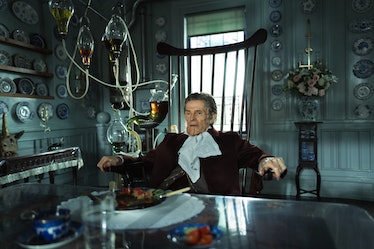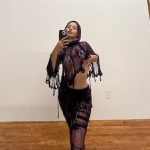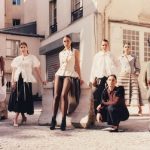In Yorgos Lanthimos’s twisted feminist tale Poor Things, Willem Dafoe plays a scarred (literally and figuratively) Dr. Frankenstein-esque mad scientist named Godwin Baxter, who takes the body of a young woman near death and implants an infant’s brain in her head, turning her into a whole new being. It’s a reanimation tale, a coming-of-age story, a sci-fi epic all rolled into one, with Dafoe’s Godwin as the mastermind of Emma Stone’s experimental character, Bella Baxter. But behind the scenes of the film, there were two other women—the real Dr. Frankensteins, if you will—who brought Stone, Dafoe, and the rest of the fantastical cast to life.
“I think Emma said it herself: we were creating a woman from scratch,” hair, makeup, and prosthetics designer Nadia Stacey tells W over Zoom. Yes, Godwin (or God, as Bella affectionately—and naively—calls him in the film) is the genius behind this human experiment, but it was Stacey, along with costume designer Holly Waddington, who took the Oscar-winning, Arizona-born Stone and turned her into the British Victorian-era baby Bella Baxter.
The process of creating Bella began with the book of the same name by Alasdair Gray, on which the film is based, and Tony McNamara’s screenplay. “Everything always comes from the script,” says Stacey, who worked with both McNamara and Lanthimos previously on 2019’s The Favourite. But words can only get you so far, especially in a surreal world like Poor Things’s, where the time period is up for debate. There are clear Victorian influences, but a cotton-candy Lisbon sky filled with trams and Godwin’s still-impossible experiments deliver something completely other worldly. Stacey and Waddington therefore found inspiration in Shona Heath and James Price’s production design for the film, which used the late 1800s as an anchor before adding that signature Lanthimos twist.
One of those spins comes in the form of Bella’s hair, which grows at a rapid pace throughout the film. While women of the Victorian era wore their long locks in elaborate braids and curls, Bella lets hers run wild. “She doesn’t have any societal restraint,” Stacey says. “She wouldn’t know that women tie their hair up and she shouldn’t have it loose like that.” At its most extreme, the extensions Stacey added to Stone’s jet-black hair reached 42 inches.
In addition to Victorian times, Waddington’s inspiration came from a mixed bag of periods ranging from the Elizabethan era to the 1980s. “I was blitzing ideas, just throwing things up on my walls,” she says of the period she called “concept time,” when she was first preparing for the project. “We were looking at surrealist designers of the early 20th century, like Elsa Schiaparelli. There were also ’60s Space Age designers up there.” Through her research, Waddington found heavy fabrication was trendy during the Victorian era, but made the decision to steer away from that weight when designing for Bella. She kept the silhouettes of the time, but paired them with modern fabrics—diaphanous organzas and even some plastics. “Changing the fabrication didn’t firmly root things in a time or place,” she says.
When we first meet Bella post-reanimation, she’s at the piano—a grown child discovering the instrument for the first time—surrounded by fabric making up the enormous shoulders of her top. At this point, Bella is mentally a toddler, gamboling around God’s house, exploring the world through new eyes. She’s dressed in nightgowns, bloomers—the underpinnings of more elegant clothing, not meant to see the light of day.
“Yorgos was very keen that she not be obviously dressed like a child,” Waddington says. “Originally, the plan was for her to be dressed more like an upper class woman, and when we opened the film, she’d be sitting in a full suit playing the piano. Then the idea of this proper woman would be immediately shattered by her physicality.” In the end, they returned to Bella as baby. They pictured her getting dressed in the morning by the Baxters’s maid, Mrs. Prim, then toss aside items of clothing throughout the day, much like a child would. “She’s lost her skirt and she’s in her knickers, or she isn’t wearing shoes anymore,” says Waddington. “Maybe the blouse is still there, but she’s missing all the bits from the lower half.”
By the time Bella heads to Lisbon with Mark Ruffalo’s unraveling rake, Duncan, Mrs. Prim is no longer around to help her get dressed for her misadventures around the city. She has the wardrobe of a proper Victorian woman, but she has the freedom to style it like the autodidact she is. “She hasn’t been brainwashed over the last 30 years about sartorial rules, so she just wanders around the city without her pants,” Waddington says. Victorian dressing experts will recognize traditional pieces worn in untraditional ways. There are knickers and petticoats, ruffled dickie-like fill-ins worn as a top, and bodices flipped around and styled like a jacket. “For me, her mish-mash outfits were a little bit like imagining what an eight-year-old might do,” the costume designer says. “It’s like a child getting dressed up in their mom’s clothes. It still looks good, but it isn’t proper.”
Before long, Bella and Duncan are on a cruise ship, where arguably the most dramatic scene in the film’s 140-minute run time takes place. A disenfranchised Bella joins her new friend, Harry Astley (Jerrod Carmichael) on a jaunt to Alexandria, where she faces the reality of poverty and misfortune for the first time. In this scene we find Bella wearing a full-white ensemble, the first proper outfit she puts together on her own. The choice to finally place Bella in a complete, socially appropriate look represents a kind of apotheosis for the character, marking a milestone in her development: she’s able to look outside of herself, and take in the world around her.
Of course, the outfit also provides a stark contrast between Bella and her bleak surroundings. “It’s an expression of her class and the abject poverty and misery,” Waddington explains. “There’s the ridiculousness of all of this wealth and this white outfit with these massive sleeves. I wanted it to be almost clown-like.”
Each new phase of Bella’s evolution brings with it a new style of dressing. When the character enters a brothel, she wears beige tones and nylon tights (Waddington explains that clothes associated with sexuality are very often based in corsetry and stockings, with a dark, sultry color palette.) Later, when Bella enters a dark academia phase, she swaps her sex worker digs and turns toward a more Gothic look.
A thigh-length, A-line coat with puffed sleeves is the cornerstone of this new wardrobe, which she wears while attending medical school. “At this point, the clothes are getting more serious—she’s found her way,” Waddington says of the transformation. The lightweight pieces of Bella’s “youth” are traded out for more sturdy, masculine staples to blend in with the male students at school. But this is Bella—and she’s going to do things her own way. “She steps out and she has these bare legs,” Waddington says. “I just thought that was so funny.” In fact, it was Stone who had the idea to ditch an under-piece for the coat. “We were in the fitting and Emma looked at me and said, ‘I’m sure she’d just wear this, she wouldn’t bother with the skirt.’”
The only remnant of that old Bella lives in the form of her voluminous sleeves, a constant thread that weaves itself throughout the character’s wardrobe. “Big shoulders are associated with the ideal male body,” Waddington says, citing an association between the years women experienced more flexibility and freedom in society and shoulder widths on popular dress styles. Waddington, admits, though, that while designing these looks with blooming arms, she wasn’t intellectualizing the reasons behind them. The stylistic choice wasn’t even one she made. “I was offering lots of options to Yorgos and he really liked the sleeves,” she says. “It was very much his decision to do them.”
The clothes in Poor Things, as with Stacey’s hair and makeup, tell a story—but in a way that doesn’t overpower McNamara’s dialogue, Lanthimos’s storytelling, or Heath’s and Price’s world-building. Sewn together like the grotesque prosthetics on Dafoe’s face (which, in reality, took no more than three hours to apply; though the actor claims it was closer to six), this group becomes their own kind of Dr. Frakenstein, bringing the Poor Things universe to life together.



